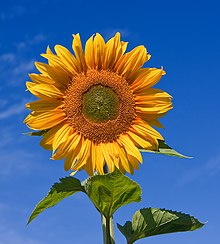| Helianthus | |
|---|---|

| |
| Common sunflower (Helianthus annuus) | |
| Scientific classification | |
| Kingdom: | Plantae |
| Clade: | Tracheophytes |
| Clade: | Angiosperms |
| Clade: | Eudicots |
| Clade: | Asterids |
| Order: | Asterales |
| Family: | Asteraceae |
| Subfamily: | Asteroideae |
| Tribe: | Heliantheae |
| Subtribe: | Helianthinae |
| Genus: | Helianthus L.[1] |
| Synonyms[1][2] | |
|
Harpalium (Cass.) Cass. | |
Helianthus (/ˌhiːliˈænθəs/)[3] is a genus comprising around 70 species of annual and perennial flowering plants in the daisy family Asteraceae commonly known as sunflowers.[4][5] Except for three South American species, the species of Helianthus are native to North America and Central America. The best-known species is the common sunflower (Helianthus annuus).[6] This and other species, notably Jerusalem artichoke (H. tuberosus), are cultivated in temperate regions and some tropical regions, as food crops for humans, cattle, and poultry, and as ornamental plants.[7] The species H. annuus typically grows during the summer and into early fall, with the peak growth season being mid-summer.[8]
Several perennial Helianthus species are grown in gardens, but have a tendency to spread rapidly and can become aggressive. On the other hand, the whorled sunflower, Helianthus verticillatus, was listed as an endangered species in 2014 when the U.S. Fish and Wildlife Service issued a final rule protecting it under the Endangered Species Act. The primary threats to this species are industrial forestry and pine plantations in Alabama, Georgia, and Tennessee. They grow to 1.8 metres (6 feet) and are primarily found in woodlands, adjacent to creeks and moist, prairie-like areas.[9]
The common sunflower is the national flower of Ukraine, cultivated there for several centuries.[10]
- ^ a b "Helianthus". Germplasm Resources Information Network. Agricultural Research Service, United States Department of Agriculture. Retrieved 22 February 2011.
- ^ "Helianthus L." World Flora Online. World Flora Consortium. 2023. Retrieved 8 February 2023.
- ^ Sunset Western Garden Book. Leisure Arts. 1995. pg. 606–607.
- ^ Schilling, Edward E. (2006). "Helianthus". In Flora of North America Editorial Committee (ed.). Flora of North America North of Mexico (FNA). Vol. 21. New York and Oxford: Oxford University Press – via eFloras.org, Missouri Botanical Garden, St. Louis, MO & Harvard University Herbaria, Cambridge, MA.
- ^ "Sunflower Production". North Dakota State University. Archived from the original on 18 August 2016. Retrieved 12 July 2016.
- ^ Shorter Oxford English Dictionary (6th ed.). United Kingdom: Oxford University Press. 2007. p. 3804. ISBN 978-0-19-920687-2.
- ^ RHS A-Z Encyclopedia of Garden Plants. United Kingdom: Dorling Kindersley. 2008. p. 1136. ISBN 978-1-4053-3296-5.
- ^ "Conservation Plant Characteristics - Helianthus annuus L. common sunflower HEAN3". USDA - Natural Resources Conservation Service. Retrieved 1 April 2019.
- ^ Remillard, Ashley (August 4, 2014) "U.S. Fish and Wildlife Service Issues Final Rule Protecting Three Flowers" Archived 2014-08-12 at the Wayback Machine Endangered Species Law and Policy Blog, Nossaman LLP
- ^ Sommerlad, Joe (10 April 2022). "What Is The National Flower Of Ukraine?". independent.co.uk. Independent. Retrieved 2022-08-03.